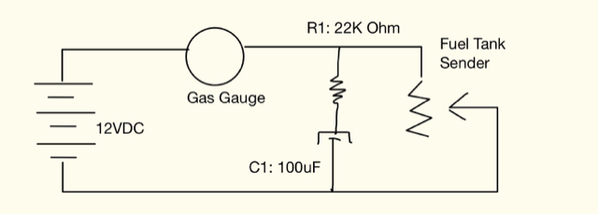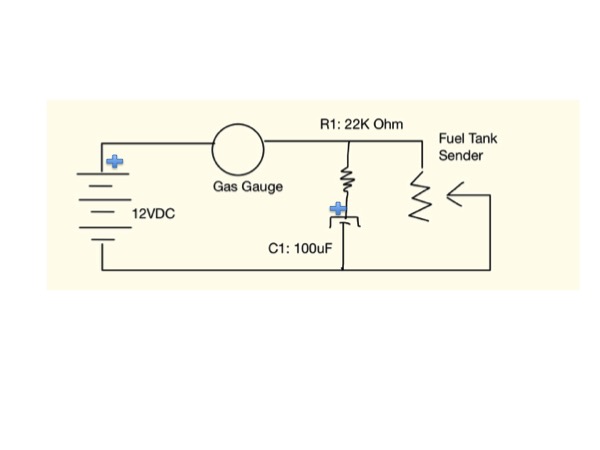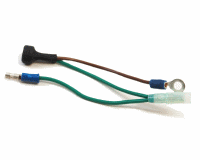Replies sorted oldest to newest
I use a tube-type Karmann Ghia sender and it is pretty stable.
Well, Ray, first of all it is expecting to work at 6 volts, so you would need to find one that is suited to 12 volts. Poke around elsewhere for a 12 volt version.
I have heard both arguments that a simple capacitor in parallel with the gauge needle coil(s) will or will not provide a dampening effect. Both of these arguments may be right, depending on capacitor (value and characteristics) used, as well as the meter movement used in the gauge - you’re developing a semi-tuned circuit, after all.
OTOH, an ultra capacitor might just do the trick, again, depending on the gauge movement.
Either way, $28 buckeroos for what appears to be an ultra capacitor is a little stiff (or that little wiring harness has gold-plated wiring or something).
But you’ve piqued my curiosity about ways to do the dampening effect so I think I’ll look into it and see what I find. I’ve always thought that if you were to somehow average out the variable voltage produced by the sender as the float moves, you could get the needle to show an average which would be close to the actual level. An ultra capacitor might just do that.
Stay tuned.
A couple of things: On VW Beetles there is a ( I guess the word vi brator is banned here ) that is wired to keep the needle from bouncing. On you car if the float orientation is front to back instead of L to R or R to L it will throw the needle around.
I figured the idea had some merritt Gordon.
I've heard that term of a "vi brator" used to describe a VW gauge dampening device. If I dig deep enough I may still even have one in the shop attic and if I do I'll take the thing apart to see what's inside. The idea of using some sort of a "vi brator" (I'm thinking of those big cans used in early car radios and also called a vi brator) in that application on a gas gauge simply makes no sense to me, so it must be something else inside.
BTW, those early car radio vi brator were a 6 volt relay set to open and close at a specific frequency (somewhere around 400 hertz, I believe) that turned the 6 volt DC input into 400 hertz simulated AC (square wave) that was then increased in voltage by a transformer into higher voltages needed for the vacuum tubes used in the radio (usually 45 - 250 volts).
Well, I'll be damned.......
The VW thingie is a vi brator! ![]()
Here's the can.
And here's what's inside. A simple bi-metalic strip that continuously makes and breaks contact with the wire going from the sender to the gauge. Now I have to figure out how (and how well) it works in my gas gauge circuit.
Ray! Get a 12 volt version of that other thing and check it out for us!
Attachments
Gordon I have a custom made tank with a bosch guage so I don't have access to it. I posted it for you guys ![]()
I think that the gizmo you showed earlier is wired in at the Gauge end, not at the tank.
Alan Merklin posted:...there is a ( I guess the word vi brator is banned here ) that is ...
********-
vi brator- I guess it its. Of all the stupid...
PS- nothing more to contribute (I had to know....)
OK, MAJOR BREAKTHROUGH TIME!!!!!!!!!!!!!
I sat down and started playing with the formula for an R/C circuit (resistance/capacitance) and quickly needed the assistance of my Engineer wife who came up with a spiffy little calculated circuit calling for a 22K resistor and a 100µf electrolytic cap. Trust me, you do not want to see the formulae she used, although she seemed pretty comfortable with them - I’m not ![]()
The circuit looks like this:
That’s the good news. The bad news is that I don’t have a 100µf cap in stock (this ain’t “Radio Shack”, after all....) All I could find was a 50µf which, from her calcs, will give me a faster full charge time but about 50% less of a dampening effect. In other words, instead of averaging over 5 - 10 seconds, it averages over 2 - 5 seconds. Well, Howdy. What’s that gonna look like?
So the next step was to turn Pearl in to a lab mule and play with the parts I have on hand, putting it together with alligator clip wires. And the road test results are.........
Exactly what my senior lab assistant’s calculations showed they would be; The needle still moves, but over the same section of road (same direction) the needle moves about 1/2 of what it does without the damping circuit installed - about 3-4 needle widths above and below the average (as opposed to +/- half a tank before!) The calcs say going to the larger cap should pull that in to within +/- 2 needle widths as it averages (charges/discharges the larger cap) over a longer period.
So, there you have it. I still don’t know how the heck that VW vi brator works, nor do I wish to find out.
You want to reduce the jumpy needle in your VDO-style 356 gas gauge? Get a 22K 1/2 watt resistor and a 100 µf electrolytic cap and wire them in per the diagram above. Battery “+” is at the top, “+” side of the capacitor is UP, battery ground is at the bottom and the cap’s “-“ end is grounded. It makes no electrical difference whether they are connected at the gauge end or sender end, whichever is easier to install and can be insulated easier.
Attachments
Sure, that’ll work, but “ships in 2 to 4 WEEKS???
You can do better than that on Amazon.......
Any 100µf 35 - 50 volt electrolytic will do. The lead length tells you polarization.
And don’t forget the 1/2 watt resistor - 22K ohms (red, red, orange)
I love it when stuff is cheap to fix.
That's good math Kathy! Great idea, and execution.
Easy to solder and heat shrink the two components, and put the ground under a sender bolt(there are 5) and hook the other end to the sender itself. Find a male/female tap or T in the auto parts store so you can add a lead.
I kinda felt like living in a "Dilbert" cartoon when the "Pointy-Haired Boss" comes to his Engineer with a "great idea" that he can't design himself and the Engineer takes off and whips up something off the top of her head. But it was fun to watch her whip through the formulae and she got to use the "scientific" side of her iPhone calculator app.......
Attachments
@Gordon Nichols I was thinking of this circuit and it reminds me of a circuit that I just bought as a Lane Changer/6 flash module. Kahtec lane changer that I posted before.
The unit essentially is wired into the signal light switch circuit and to each side of the signal lights and whenever it senses a pulse of so many milliseconds, accomplished with your signal light lever switch, it will flash 6 times the signal side that you have chosen. Eliminates you forgetting your signal light on. ![]()
Lots of neat things can be done with a few small circuits... love this kind of stuff.
I have that, but had to buy a Nissan Rogue to get it.
It gets more expensive that way, tho........
I have been looking at the newer cars lately and they really are not too exciting. The amount of technology for accident prevention and lane correction is more than annoying. I even checked the new van offerings and you get a 9 or 10 speed tranny, but you don't really get any more mileage than a 6 speed but you get all the extra complexity. Just look at the digital dash that is being offered if you do not have extended warranty it could be a humongous invoice down the road. There goes user repairs.
Just saying.
We're a van family. I've got two minivans and two work vans in the driveway. Regarding 9-10 speed transmissions vs. 6-7 speed transmissions:
More is more. The Pacifica is easily 5x as good as the T&C in any situation. They have the same engine, but the experience is night and day.
new cars not exciting..U need to drive my 17 Por 911 CS, 420HP,,has 3 different exhausts on it (PSE),factory twin turbos,,I have a poop eating grin everytime i get on it
Well, since it costs the same for one each cap and resistor as it does for 10 each, I bought 10 and will have a few extras and can make up a few kits.
As envisioned by Danny P. (clever Spydah-guy that he is...) the electronic stuff will be enclosed in shrink tube for insulation and the kit will include a 1/4" fast-on tab "T".
Installation will be to remove the sender wire at the tank, push the "T" onto the sender tab, re-attach the sender wire to the other side of the "T".
Attach the damper 1/4" fast-on tab to the remaining "T" tab.
The other damper wire will have a horse-shoe tab that is fitted under a convenient sender assembly mounting screw for ground (it will not be necessary to remove the screw, just loosen it).
That's it. I should have the prototype built and tested by the end of the week. There's a little bit of labor involved to make up the kits, so I'll have 8 or so available for, say, $20 bucks each, post-paid.
If you wish to calm your gas gauge down, this might be for you.
Anyone interested?
Before you ramp up production, Gordon, you might want to ask your lead engineer if the resistance of your sender entered into her calculations and if the values in your kit might need to vary for different senders.
And the answers are Yes, I mentioned the possibility of different sender resistance and it probably won't matter - our circuit is just averaging a varying voltage and doesn't care what that voltage is.
Once the cap charges to whatever voltage the sender defines, the cap acts like an open circuit, floating at whatever voltage it sees from the sender wire.
As the gas float drops, the voltage level in the circuit changes (could be up, or down, depending on the gauge and sender design). The cap will resist this change by absorbing voltage or adding voltage to the circuit, depending on swing direction. The resistor slows down how fast that happens. By varying the resistor and cap values, you can change the charge/discharge time, and vary how quickly the needle stabilizes. When the float stops moving, the cap charges to that sender voltage and sits there.
I haven't tested this yet, but this should also cause a slower swing from zero to the current fuel level when the ignition is first turned on. Same thing when you fill the tank. 2 - 3 seconds or so, just like our old Honda gas gauge.
Gordon Nichols posted:. . .
Anyone interested?
I'm interested!
Gordon I think some are 90 ohms at full or empty can’t remember at this point.
I just checked and it goes 0-90 most times
Ray, my circuit change doesn’t care what the sender or gauge is. It doesn’t care if the ohms reading is low at empty or high. It doesn’t care what the sender ohm swing (empty to full) is, either.
All it does is sample the sender-to-gauge voltage, not resistance. Once the capacitor charges to that arbitrary voltage (where-ever the float is), it then seems to disappear (in reality, it acts like an open circuit because the voltage sampled and the voltage inside of the cap are the same - it’s like when your alternator produces positive voltage and the dash light goes out). It then tries to bring any voltage change it sees to an average of plus and minus swings as the voltage changes. That’s it. Pretty simple, like me.
Ted: Got'Cha!
Oh yeah, I'd like one of those, G.
OK, here's the latest.
The circuit works as predicted and decreases the needle movement by half or so. Remember - our gas tanks have no internal baffles in them so the gas is allowed to slosh around at will and can make the float go from zero to almost full if there is less than half a tankful, and the only circuit that can handle that type of swing has more intelligence (and a lot more cost) that what I made. My circuit will cut down the nervous wiggle of up and down a 1/3 tank around the actual fuel level to something +/- 1/8 tank on most roads. It still can't handle those radical swings below a half tank (remember - no tank baffles) but it calms the needle down so you can actually guesstimate what is left in the tank down there and be pretty accurate. All of my testing was around 1/4 tankful.
Dave, the the owner of one of the local NAPA stores, has known me since we were both kids, back in the 70's. When I went tearing in to get a bunch of crimp connectors and he found out what I was doing with them, he donated them to the members of the SOC! That cuts my product cost down a lot so I am now selling them for 50% off my original price, or $10 bucks each, postage included, to SOC folks, up to 9 units (that's all I've made, extra).
What you get for your hard-earned moolah is an easy-to-install module that is enclosed in shrink tube, as well as a 1-to-2 tab adapter for the sender terminal, as shown. If you choose this route, PM me with your mailing address and I'll get one out to you and tell you how to pay for it:
If you choose to go it alone (intrepid hobbiest that you are), you'll need a 100µf electrolytic capacitor for 35 volts, a 22K ohm 1/2 watt resistor, a 3/16" ring-tab crimp terminal, a hooded 1/4" tab crimp connector and various sizes of shrink tube.
The capacitor and resistor are connected together as in this schematic:
The minus (-) lead of the capacitor is marked on the side of the case with a colored stripe and "-" and is usually the shorter lead. The minus lead goes to ground (a sender mounting screw) and the "+" side of the cap attaches to one side of the resistor. The other side of the resistor attaches to the sender output lead via the 1-to-2 adapter.
To install the module, turn off the ignition and remove the key to eliminate temptation (I know you'se guys).
This is what you start with on your gas tank sender, probably under your carpet:
Remove the red lead from the 1/4" center tab on the sender and install the 1-to-2 adapter in it's place:
Attach the original sender wire to one side of the 1-to-2 adapter:
Remove one of the sender screws (check length of the module to available screws and choose one within reach). Leave the fiber washer in place against the sender disk:
Slip the ring tab onto the sender screw and return the screw, tightening firmly but not too tight, then slip the hooded 1/4" fast-on tab onto the remaining adapter tab on the sender. It should now look like this:
If you are concerned about putting something on top of the tank in the frunk that might apply too much pressure and possibly short something out, slide a layer or two of duct tape under the 1-to-2 adapter and another piece of duct tape on top of the adapter. As you can see above, my original sender lead has a non-insulated (non-hooded) connector that might prove troublesome. If your original sender wire terminal is hooded/insulated this precaution is probably not necessary.
Cover your tank back up with your carpet and you're done.
Again, if you're interested in a fully built and road-tested module ready for installation (and how many things on these cars install THIS easily?), PM me with a mailing address and I'll give you payment info. I have nine for sale to the first PM'ers after Edsnova and Ted, so there are seven left but once they're gone you're on your own with the build instructions above (or get some local "Robotics Kid" to build one for you).
Our Five Cent Racing Customer Service personnel are waiting by their keyboards......
Attachments
Is there any reason why this couldn't be patched in at the gauge itself and grounded elsewhere?
Ted: Absolutely none.
If you want to do this at the gauge, you can use the same "T" adapter on the sender wire at the gauge and just ground the other end of the module to a ground stud on the gauge can or any other ground point you can find up in there.
Electrically, it doesn't care.
Just let me know (anyone) if you want a gauge version and I can give you a 6" long "flying lead" on the ground end (just a longer wire with ring tab on it).
gn
Sign me up for one of those anti-gas gauge wobbly thingies. PM me on how you want your dough.
Mike
I'll take one as well, Gordon. Thanks. Lemme' know how you want paid.
News Update For VS Drivers
Maybe you're like me and have so much junk in your frunk that you haven't actually looked at your fuel sender in a while.
I thought it was buried under the carpet, like in Gordon's photo:
But it's not!
Amazingly, VS left a cutout in the carpet to access (or replace) the sender, so installing the dampener is that much easier.
No such luck with the steering box, though.
Attachments
Gordon. I’ll take one. PM me payment method. Thanks for the tinkering on this.
OK, so far I have:
- Ted
- Edsnova
- Mike Pickett (Mahalo!)
- Stan the Traveling Vagabond
- Geno
- Sacto Mitch
and a couple left.
And I'll take one. I am an intrepid hobbyist, but a tad lazy. Let me know how to get you the bucks. Thanks, Gordon and your consulting engineering staff!
Stan Galat posted:We're a van family. I've got two minivans and two work vans in the driveway. Regarding 9-10 speed transmissions vs. 6-7 speed transmissions:
More is more. The Pacifica is easily 5x as good as the T&C in any situation. They have the same engine, but the experience is night and day.
I have had two T&C in the past older versions and I have had multiple Honda vans. The latest have 9&10 speeds and I just found the reports that they are not as good or at least have more breakdowns with minimal benefits.
Having owned many of them transmissions were an issue in an 2001 that I owned so i am learly of going for the new model ...
Gordon, just as an FYI, NLA/ Stoddard make this for the 356 porsche guys... same concept, but made to be installed on the gauge end of business. Not sure what size resistor they use. 25$ plus shipping.
yours is a BARGAIN!!!
KUDOS to your wife for figuring the math out.,, I took the trial and error approach last summer. (one of the local radio sharks was going out of business so I purchased a bunch of capacitors/resistors on sale and spent a Sunday playing around!)









